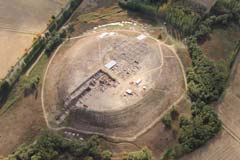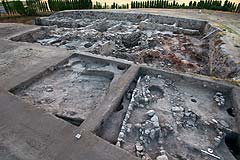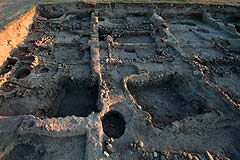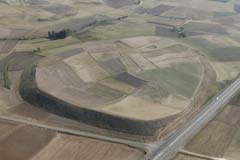Japanese Institute of Anatolian Archaeology has conducted excavations at the site of Kaman-Kalehöyük (Kırşehir) and a regional survey in Central Anatolia since 1985. Additionally, the institute began preliminary research at the site of Yassıhöyük (Kırşehir) in 2007, and at Büklükale (Kırıkkale) in 2008.
The results of the work are reported every year in Anatolian Archaeological Studies and at an annual conference held at MECCJ in Tokyo. The results of the work carried out in 2008 will be reported at the conference to be held 28-29 March 2009 at MECCJ.
Kaman-Kalehöyük
About the site

Kaman-Kalehöyük (2008)
Kaman-Kalehöyük is in Çağırkan village, Kaman, Kırşehir province, Republic of Turkey. It is situated about 100 km southeast of Ankara, the capital city of Turkey, about 3km east of the city of Kaman, and south of National Route 260. It is a medium-sized, mound site 280 m in diameter and 16 m high.
JIAA conducted preliminary research at the site in 1985, and then the excavation was started with the first spade of earth by Japan's H.I.H. Prince Takahito Mikasa as the President of MECCJ in 1986. Research investigation has been conducted continuously since then.
Four main cultural periods have been identified at the site: Ottoman Empire/Byzantine Period, Iron Age, Middle and Late Bronze Ages, and Early Bronze Age. Artifacts belonging to the Chalcolithic Period and Neolithic Period have been found, so these cultures may also have existed at the site, though no settlements from these periods have been excavated yet.
The four archaeological levels are named as follows:
- Stratum I: Ottoman Empire Period (15th ~ 17th c. A.D.)
- Stratum II: Iron Age (12th ~ 4th c. B.C.)
- Stratum III: Middle and Late Bronze Ages (20th ~ 12th c. B.C.)
- Stratum IV: Last half of the Early Bronze Age (3rd millennium B.C.)
One of the objectives of Kaman-Kalehöyük excavation research is to construct a cultural chronology of the site. The research has led to some new ideas about the ancient history of Anatolia. For example, the period after the collapse of the Hittite Empire, from the 12th to 8th centuries B.C., in the Iron Age, has been called the "Dark Age" as it was considered to be without any significant culture. However, excavation of Kaman-Kalehöyük Stratum IId, belonging to the early part of that "Dark Age " period, has revealed a series of occupied levels and material culture. In the levels belonging to the 2nd millennium B.C., a succession of cultural levels can be clearly seen, from the Assyrian Colony Period, Old Hittite Kindom, and Hittite Empire Period. Artifacts that raise new opinions about when the Iron Age began are excavated one after the other.
The 23rd Kaman-Kalehöyük Excavation (2008)
In the end of May 2008, we removed the protective roof that covers the site during every winter season, and from June to early October we cleaned the site, performed new excavations, and catalogued, studied, and conserved artifacts. The site was photographed from the air using a balloon. Excavation research at Kaman-Kalehöyük is aimed at constructing a full stratigraphic sequence of the site in the North sections and understanding the extent of the Iron Age settlement in the South sections.

North sections at the end of the 2008 excavation season.
Front right is section XXXV, front left is section XXXVI.
In 1994 and 1995, in sections 0, I, XII, XXI~XXIV and XXVII~XXX in the middle of the site, severely burned architectural remains consisting of many rooms and belonging to the Assyrian Colony Period were excavated. In this large structure, over fifty human skeletons* were unearthed, and from a nearby structure, two inscribed clay tablets belonging to the Assyrian Colony Period were found. Based on these finds, these architectural remains were thought thought to house an ancient archive. In 2008, in order to understand the total extent and context of these architectural remains, two new sections were opened to the west of the sections mentioned above, North sections XXXV and XXXVI. It is hoped that further study of this large structure will help to reveal activities of Assyrian merchants in Central Anatolia. Excavation in the new sections uncovered architectural remains belonging to Stratum I, the Ottoman Empire Period. It will take a few more years to reach the layer belonging to the Assyrian Colony Period. As excavation proceeds, each cultural layer will be studied and compared to layers already excavated in the North and South sections.
*All human remains excavated at Kaman-Kalehöyük are being studied and will be preserved in a respectful manner for our future research.
South sections at the end of the 2008 excavation season
In the South sections, the Iron Age settlement was the focus of research. The Iron Age at Kaman-Kalehöyük is divided into four levels: Stratum IIa, IIb, IIc and IId (from youngest to oldest). This season, the settlement dating to approximately the 8th century B.C. (Stratum IIc) was investigated. Stratum IId, just below IIc, has been called the “Dark Age” in Anatolian archaeology and is considered to be a historically and culturally trivial period. However, excavation research at Kaman-Kalehöyük has revealed that this period was never trivial but enjoyed a advanced culture. This season, research aimed at understanding how the culture of Stratum IId influenced that of Stratum IIc. Painted pottery types excavated from Stratum IIc are thought to show influences from Stratum IId. Study of these pottery types will provide clues to understanding the relationship between these two cultural levels.
Excavation at Kaman-Kalehöyük has been supported by many funds and grants-in-aid. We sincerely appreciate the generous support we have received. In 2008, the institute received grants from the following:
- Japan Keirin Association

- Sumitomo Foundation
- Seki Memorial Foundation for the Promotion of Science and Technology
- Yomiuri Shinbun Osaka Headquarters
Yassıhöyük
About the Site

Yassıhöyük (2008)
Yassıhöyük is a mound site at Çaiaız village, Kırşehir province, Republic of Turkey. It is located about 170 km from Ankara, Turkey's capital city, about 30 km from Kaman-Kalehöyük, and north of National Route 260. Japanese Institute of Anatolian Archaeology conducted research at this site and in the surrounding area during its general surveys in 1986, 1988, 2000, and 2002. Based on the potential of the site, JIAA conducted a magnetic survey, a topographic survey, a photographic survey, and a surface collection survey in 2007 and 2008.
Yassıhöyük measures 500 m north-south, 625 m east-west, and 13 m high. The condition of the site is good except that part of the east and south slopes have been lost to road construction.
The top of the mound is surrounded by high, buried features thought to be the remains of a city wall, and inside the apparent wall, three other high areas are visible. The magnetic survey indicated that in the highest part, there is an immense structure – 45~50 m in length and 40 m in width – thought to be a royal palace or a temple. Small structures thought to be affiliated with the large one and parts of another major structure were also recognized.
During surface collection, pottery shards belonging to the Iron Age (parallel to Stratum II at Kaman-Kalehöyük) and to the 2nd millennium B.C. or the middle of the Bronze Age (parallel to Stratum IIIb and IIIc) were found. The date of the immense structure indicated in the magnetic survey cannot be confirmed, but two possibilities can be proposed: the first half of the 2nd millennium B.C. or the first half of the 1st millennium B.C. The early date is proposed because the buried structure is similar to a structure excavated at Açemhöyük, an important site of the first half of the 2nd millennium B.C.; also, Yassıhöyük is comparable in size to Açemhöyük, as well as to Kültepe, another important site from that period. A possible 1st millennium B.C. date is strengthened by the find of a lead document written in late Hittite hieroglyphic text, which local people brought to the Museum of Anatolian Civilizations in Ankara.
Research at Yassıhöyük in 2008 was conducted with a Grant-in-Aid for Scientific Research (Basic Research B) from the Japan Society for the Promotion of Science.
Keine Kommentare:
Kommentar veröffentlichen